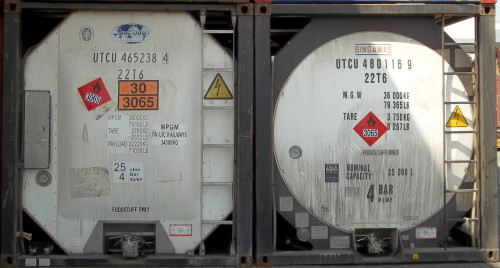One of the most efficient ways to transport liquid dangerous goods in packaged form is by tanks. IMDG Code, by giving options of varying sizes of packages, permits many Dangerous Goods in Liquid Form to be transported in tanks on board ships.

Advantages of using tanks, instead of drums, are numerous, however, tank is a specialized equipment and care by all parties at all time is necessary for an event less journey. Tank Provider, Shipper, Transporter, Carrier and all others involved in its transport may have different roles to play.
From 1st January 2010, the transport of dangerous goods in IMO type portable tanks and road tank vehicles will be permitted in accordance with columns (13) and (14) of IMDG Code only. For full details on IMO tanks refer to IMO Circular “Dsc/Circ.12 Guidance on The Continued Use of Existing IMO Type Portable Tanks and Road Tank Vehicles for the Transport of Dangerous Goods.”
When a particular liquid Dangerous Goods is allowed to be transported in UN Type tanks a Tank Code is assigned to the entry in Dangerous Goods List. Tank codes T1 to T22 are for liquid and solid substances of classes 3 to 9, T23 is for substances of class 4.1 and class 5.2, organic peroxides. The differences between T codes are based on Minimum test pressure (bar), Minimum shell thickness, Pressure relief and Bottom opening provisions.
A liquid assigned with a specific T Code in Dangerous Goods List may be filled in higher T Codes as permitted by IMDG Code. Example: HYDROGEN FLUORIDE, ANHYDROUS, UN 1052, assigned with T Code T10 may also be filled in Tanks under T Codes T14, T19, T20 & T22.
For shipping liquid dangerous Goods, if you think tank, then do the math!
For stability during transport the rule for liquids is either the tank be filled above 80% or below 20%. The most dangerous surge of liquid effecting the stability of vehicles on road is when liquid level is between 40 to 60%. To transport liquids between 20 to 80% baffle tanks need to be used. Baffle tanks have transverse surge plates fitted inside for longitudinal stability.
In a rough way we can say that the degree of filling for tank containers shall be greater than 80% and not more than 97% for general dangerous goods and 95% for Class 6.1 and 8 Liquids PG I and II.
However the actual value for each liquid shall be calculated with below formulas
- for general use maximum degree of filling (in %) is

DEGREE OF FILLING 97
- for class 6.1 and class 8 PG I & II, Liquids with an absolute vapour pressure of more than 175 kPa (1.75 bar) at 65°C or for marine pollutants maximum degree of filling (in %) is

a is the mean coefficient of cubical expansion of the liquid between the mean temperature of the liquid during filling (tf) and the maximum mean bulk temperature during transport (tr).
Liquids transported under ambient conditions, α could be calculated by the formula

d15 and d50 are the densities of the liquid at 15°C and 50°C, respectively.
The maximum mean bulk temperature (tr) shall be taken as 50°C except that, for journeys under temperate or extreme climatic conditions, the competent authorities concerned may agree to a lower or require a higher temperature, as appropriate.
Example Calculation -Cargo Details and properties

Calculation to find ‘a’ and degree of filling

Both cargo shall be filled above 80% in which Cargo 1 & 2 shall not be filled above 91.98% and 88.12% respectively.
Certain shipping lines, while accepting Class 6.1 & 8, Packing Group I or II, demand from shipper a signed statement that the degree of filling meets the respective provisions of IMDG Code applicable to the liquid filled in tank. This declaration guarantees the shipper’s compliance to degree of filling and indemnify the line from non-compliance.
Further a portable tanks shall not be offered for transport:
- With a degree of filling, for liquids having a viscosity less than 2,680 mm2/s at 20°C or at the maximum temperature of the substance during transport in the case of a heated substance, of more than 20% but less than 80% unless the shells of portable tanks are divided, by partitions or surge plates, into sections of not more than 7,500 ℓ capacity;
- With residue of substances previously transported adhering to the outside of the shell or service equipment;
3, When leaking or damaged to such an extent that the integrity of the portable tank or its lifting or securing arrangements may be affected; and
- Unless the service equipment has been examined and found to be in good working order.
Use degree of filling online calculator here
Before tanking do the math!
I wish all the readers “A Very Happy New Year 2015!”


 WhatsApp your queries
WhatsApp your queries
Many thanks, very helpful and informative. A happy and prosperous new year to you. David Bond in the UK.
David,
wish you to a very happy and prosperous new year!
Regards/Shashi
Thank you very much Shashi!
Very interesting and helpful article.
Thanks Jolanta
[…] To know more about calculating maximum degree of filling click here […]
[…] Bulk Liquids – Think Tank, do the Math! […]
[…] goods are packed into same container. When liquid dangerous goods are filled into tank containers degree of filling as prescribed in chapter 4.2 must be taken in to consideration. Guidelines for packing a container […]
[…] To know more about calculating maximum degree of filling click here […]
[…] Visit here to know how to calculate maximum degree of filling […]